28 December, 2004
What are scientists studying in Antarctica?
You can tell from previous journal entries that scientists are studying lots of things in Antarctica...too many to list here. There are probably over 100 research projects now underway! I highlighted below a few of the projects I had a chance to experience through parcticipation, attending lectures, and talking with the scientists working on the projects. The links to their websites will take you to photo galleries of their work.
Antarctica is a very, very sensitive environment and it gives scientists a good chance to study the environmental affects of pollution - when things start going wrong in the global environment, it can often detected in Antarctica. By studying penguins like Dr. David Ainley, and seals, like Dr. Robert Garrott, scientists can determine how healthy the Antarctic environment is. Dr. Ainley's website is <http://penguinscience.com/main_frame.htm>. Dr. Garrott's site can be found at: <http://www.homepage.montana.edu/~rgarrott/antarctica/index.htm>.
Scientists use huge balloons to lift scientific instruments high into the Antarctic atmosphere. Because of the rotation of the Earth, within a few days, they can recover the instruments pretty close to where they were launched. Scientists call it the "poor man's space program" because it does not cost nearly as much money to launch a balloon from Antarctica as it does to put a satellite into space. Dr. John Mitchell and a team of Japanese scientists use balloons to carry instruments to gather data to learn more about the creation of the universe and the properties of energy. As you know, energy is very important to all of us! Who knows, maybe their work will help us generate discover new sources of energy. You can visit their website at: <http://lheawww.gsfc.nasa.gov/docs/gamcosray/hecr/BESS/BESS.html>.
Meteorites can be found in Antarctica too! In fact, more meteorites have been found here than any place in the world. This is because they are easy to see on the white snow! Ice sheets in Antarctica move very slowly from the middle of the continent to the edge of the continent. In some areas, the ice sheets run into mountains and stop. The snow is removed by wind allowing layers within the ice sheet to be exposed. This loss of snow is called ablation. Eventually the ice sheets will reveal their treasure of meteorites that have been hidden under the ice and snow for thousands of years! Dr. Ralph Harvey collects Antarctic meteorites to learn more about our solar system and the universe. His website can be found at: <http://geology.case.edu/~ansmet/>
The environment in parts of Antarctica is similar to the terrain and climate on Mars. In the next decade we will land several spacecraft on Mars in search of water and other signs of life. Dr. Peter Doran is working in the Long Term Ecological Research project, and he has many studies underway. One of his research assistants, Brandy Anglen, is doing work that may help us recognize what life might look like on Mars. Another TEA teacher, Robin Ellwood, assists Dr. Doran by diving beneath the frozen cover of Lake Hoare in the Dry Valleys, a place where there is no snow. You can read Robin's journal at: <../tea_ellwoodfrontpage.html>. Dr. Doran's website is <http://tigger.uic.edu/~pdoran/home.htm>.
There are several research projects that could affect how we treat medical problems in the future. For example, Antarctic fish are able to swim in the coldest water in the world. The seawater is below the freezing temperature of fresh water. Because of the salt in the seawater, the water needs a lower temperature to freeze. Dr. Art DeVries is studying how these fish are able to survive without freezing as fish in other parts of the world would. They hope the information they learn will help us preserve organs for heart and kidney transplants.
Volcanologists and seismologists are busy studying Mt Erebus too. I think Mt Erebus is the "perfect" volcano. It has regular eruptions (about 10 per day) and it is very predictable. Dr Philip Kyle has learned a lot about volcanoes from his work here. It is really interesting to me that the seismometers used by the volcanologists have detected the scraping sounds of icebergs in Antarctica when they rub against the bottom of the ocean and against other icebergs! They call them "icequakes" and they may have an effect on volcanic eruptions at Mt Erebus. It could be that they have an effect on other volcanoes as well. Where steam vents occur on the volcano cone, interesting ice formations occur as the steam freezes. If you want to learn more about his work and see live videos of the Erebus magma lake-, you can find his website at: <http://www.ees.nmt.edu/Geop/Erebus/erebus.html>.
Dr. Stacy Kim and her team of scuba divers are in Antarctica to study the affects of man on the communities of plants and animals that live on the ocean floor. Even though it is underneath several feet of floating ice, the ocean floor around McMurdo is a rich environment as you can see in these pictures. Stacy is interested to learn about how our presence here in McMurdo has affected the life on the ocean floor. Her study is a continuation of many years of continuous observations. The website for this project has a great journal and pictures at: <http://benthic.mlml.calstate.edu/>. You can also read about "suiting-up" for a dive under the ice by Bob Zook in my November 28 journal entry.
Dr. Doug MacAyeal studies icebergs in Antarctica because they effect the global environment in many ways. Some icebergs are bigger than some of the states in the United States or even some of the smaller countries of the world. One way they affect the world is that they have a cooling affect on the water of the Pacific, Atlantic and Indian Oceans as they move away from Antarctica. Dr. MacAyeal has an interesting website about icebergs at: <http://amrc.ssec.wisc.edu/iceberg.html>.
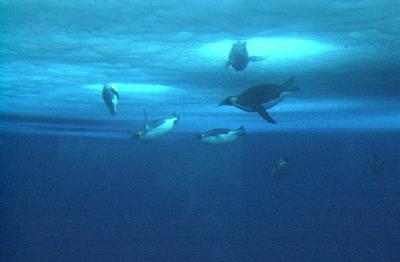
1: Penguins are birds; however, they only "fly" when they are in the water (NSF photo).
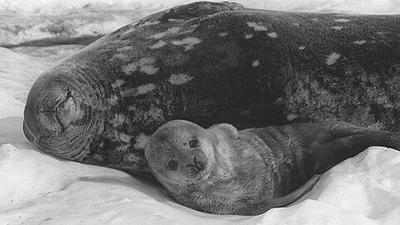
2: Seals are a good indicator of how heathy the environment is.
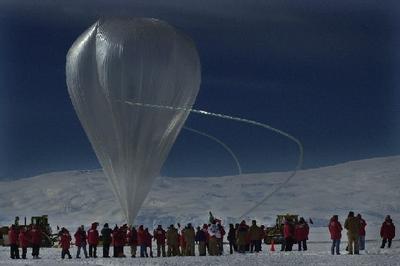
3: Giant baloons can take huge scientific instruments to the edge of space (NSF photo).
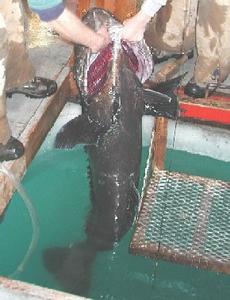
4: Huge Antarctic cod do not freeze in cold water and may provide knowledge on how to preserve organs for transplants (NSF photo).
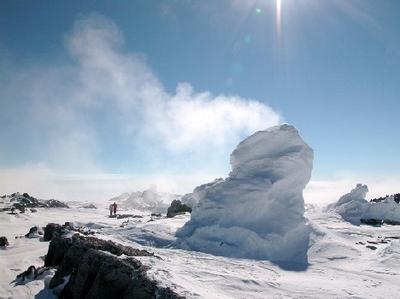
5: This ice tower vents steam and hot gas from Mt. Erebus; the steam freezes to form the tower (Rich Esser photo).

6: Underneath the ice, the ocean floor around Antarctica supports a rich community of plants and animals (Stacy Kim photo).
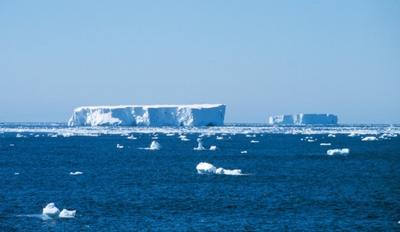
7: Algae forests form on the bottom of icebergs as they drift north, providing critical habitat for krill - an important food source for seals and whales (NSF photo).
Contact the TEA in the field at
.
If you cannot connect through your browser, copy the
TEA's e-mail address in the "To:" line of
your favorite e-mail package.
|
